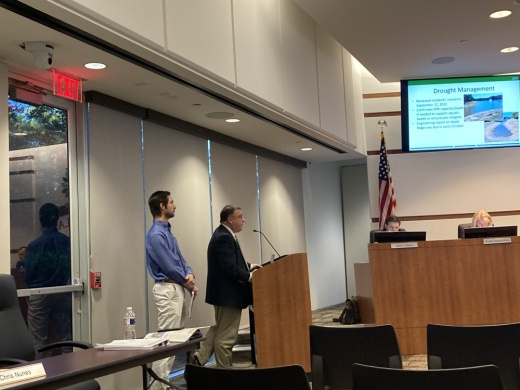Although a summer of drought conditions was alleviated by some rainfall by early September, by late October Montgomery County was again abnormally dry, according to the U.S. Drought Monitor. Montgomery County received 1.14 fewer inches of precipitation than usual in September, according to the U.S. Drought Monitor.
The Woodlands worked with engineering firm Bleyl Engineering this fall to determine the feasibility of several scenarios to divert stormwater into the most affected ponds, such as Kayak Ridge in Creekside Park. Engineering costs for the proposed project are $97,104 for the one pond, according to township materials. Another affected pond, Hullwood Park Pond, would cost about the same if a stormwater diversion approach is also used there, according to the township. The same approach could be used for ponds such as Twin Ponds and Hamlin Lake to address low water levels, officials said.
Chief Operating Officer Chris Nunes said at an Oct. 20 board of directors meeting that Twin Ponds and Hamlin Lake were below 50% and were in the process of being refilled to 50%, the most allowed under the township’s drought management plan.
Drought management practices are to fill ponds when they reach the 50% level if needed to support the health of aquatic life or the integrity of pond structures, such as piers, according to township materials.
According to the engineering firm, the only feasible option among those considered by the board was to remove and replace existing curb inlets near the ponds to direct more drainage to the ponds. Other options, such as modifying the existing storm sewer system or tying the ponds to the local water system, were also proposed, but those were not feasible because the changes would be more extensive and have wider effects than needed to maintain the pond levels, engineer Adam Vento said.
The recommended change would involve installing six inlets at Kayak Ridge Pond to capture additional stormwater and expand its collection area. If adopted, the changes could result in a water level increase of 0.79 feet north and 1.25 feet south at Kayak Ridge Pond over a five-year period, Vento said.
Drops in pond levels were inevitable given the lack of rainfall this year, officials said. Rainfall in May was the lowest level compared to normal monthly rainfall in the last five years, Nunes said. However, efforts to refill or minimize water loss could be costly and would not produce dramatic results, according to the engineering study.
“If you have a pond that’s fed by this little bit of a ... drainage area that contributes runoff, ... [and] you don’t receive any rain, well, you’re going to see drops in those ponds,” Vento said.
Officials said subsidence and fault line movement were also issues when considering township water use to fill ponds.
“One of the reasons we’ve changed a lot of practices ... water conservation is in our mind on a lot of our practices because of subsidence concerns [and] the availability of water for our community in general,” Nunes said.
Chair Gordy Bunch said these concerns are exacerbated during times of drought.
“When we shifted toward surface water, ... the movement rate substantially slowed, but because we’re now in drought conditions, the movement rates are showing at a greater rate along faulting areas and traditional subsidence,” Bunch said.
Bunch referenced a University of Houston report published in August that indicates a high rate of subsidence in the Houston area with “groundwater/hydrocarbon withdrawal being considered the primary cause,” according to the report.
Nunes said the option being considered to fill ponds with runoff, therefore, looks to methods other than groundwater withdrawal to bring ponds to healthy levels.
In response to a question for Director Shelley Sekula-Gibbs, Vento said the ponds would also need to evaluated to ensure that during a major rain event the ponds would not pose a flooding threat to the homes nearby.
Because Creekside Park is located in Harris County, work affecting the ponds discussed by the board of directors Oct. 20 would need to receive approval from county officials, according to discussion.
The board did not take action at the Oct. 20 meeting and agreed to continue discussing the matter.





